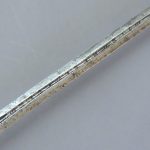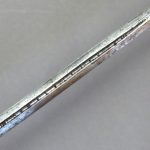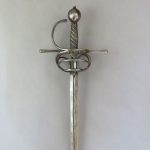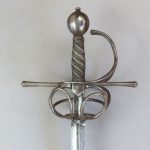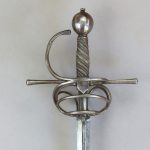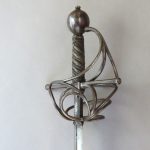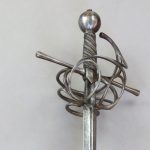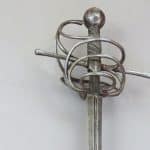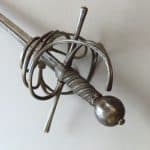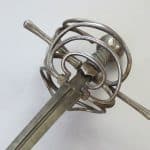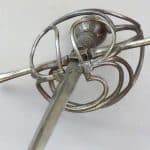
A Fine German Swept Hilt Rapier dating to circa 1600
To enquire about this itemplease click here
Price: £7,500
Ref: 42501803
Item Description
A fine, imposing and attractive German Swept Hilt Rapier dating to circa 1600. The rapier is a nicely balanced and well forged weapon in original condition with a consistent smooth grey mottled patination all over having never been invasively cleaned. The hilt type is illustrated in many portraits of late 16th / early 17th century date located across Europe including England, Scandinavia and the German States. This indicates that the swept hilt rapier was very popular amongst the social elites in countries across the region at the time. The rapier retains its full length 46.5 inch (118 cm) imposing blade. The overall length is 52.5 inches (133.5 cm).
The complex hilt is an elegant example of the armourers’ craft formed with attractive flowing curved bars of rounded octagonal section. The hilt is built around the strong quillon block which has short downwardly pointing langets which lie either side of the ricasso. Two straight quillons extend from the block, filed with decorative ribs at the join, and swell gently towards their terminals. To the front the knuckle bow curves upwards to the pommel and has a similarly swollen terminal.
Beneath the block two outwardly curved symmetrical finger, or pas d’ ane rings, extend downwards and terminate in square pads at the end of the ricasso. The outer guard consists of three ring guards and the inner guard of two circles joined by curved bars. These features on each side are supported by subsidiary bars which converge on the pas d’ane ring terminal pads which are engraved with cross-hatching on the outside. The hilt is further strengthened by two upper side guard bars, which are forged onto the outer edges of the outer and inner guard assemblies, and curve upwards to join the bow just above half way.
The multifaceted ovoid pommel has an integral waisted button on top and a grooved flared neck beneath. The original spirally grooved wooden grip tapers slightly towards the pommel and is of oval cross section, laterally bound with thin twisted steel wire, which is further bound with contra-twisted wire ropes depressed into the grooves with the ends secured underneath “Turks Heads” mounted top and bottom woven from steel rope.
The gently tapering blade is of fine quality. It is of stiff section intended primarily for thrusting and secondly for cutting. The thickened ricasso has a deep central groove extending from the hilt to the pas d’ane ring terminals on each side. Beyond these the blade broadens with a short external extension of the ricasso, after which a deep central fuller extends along each side for 17.5 inches (44.5 cm). The fullers are stamped with indistinct bladesmith’s identity letters and marks inside. Beyond the fuller terminals a mark resembling an anchor is stamped on each side after which the blade is of flattened diamond section to its tip.
A small patch of minor old pitting is present on one of the secondary guard bars attached to the knucklebow as can be seen in the images. Otherwise the rapier is in fine condition.
For more information regarding other examples and locations of rapiers, and depictions of rapiers, of this type, see A.V.B. Norman, “The Rapier and Small-Sword 1460-1820”, Arms & Armour Press, 1980, pp. 120 to 140.


